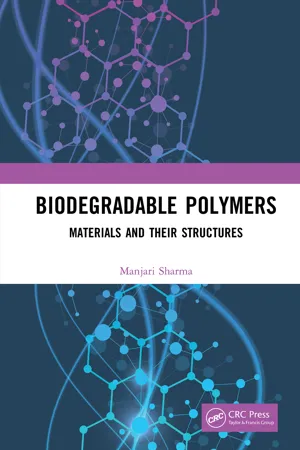1.0 INTRODUCTION
Petroleum resources are depleting day by day. Synthetic polymers produced from petroleum resources have taken a special space in our daily routine. This is due to their cost and easy fabrication process. They have been widely used by different sections of our society. In our daily life plastics are used to such an extent that the disposal of the used plastic products has created great problem. On the other hand there are certain applications where polymer needs limited life time i.e. biomedical application, disposal packaging, mulch films etc. Hence, there is a need to develop a biodegradable polymer which may be used in environmentally sound manner with respect to its specific use.
There is a shift in our approach from petroleum resource based processes to life sciences based processes. Natural materials has a broader base of materials, including plant derived products and fermentation products. The move from “ petroleum to potatoes” is internationally driven. This is indeed a challenging field of research and innovation with unlimited future prospects.
If we carefully manage the entire process there is no chance of failure. Hence, we need to take care before choosing the products for our daily life use. Coming scenario in the world is approaching for the same. Although phrasing in words and converting into reality is challenging, but efforts made in the direction will definitely provide positive results.
The environmental and regulatory drivers are encouraging industry to develop and engineer products with an approach of “cradle to grave”, which requires to manufacture the product from natural resources and to dispose-off the product in environmentally sound manner after their useful life.
At the same time societal drivers will have to take lead in accepting only environmentally friendly materials although they may cost little more in comparison. The societal change could be such a big factor which can have chain reaction and would compel the industry to only produce environmentally sound material even it may cost more. It can be seen in new generation, having been set by teaching community, that they are automatically tilted towards a better option, which is eco friendly irrespective of item cost.
Available resources can be classified as renewable and non-renewable. Renewable resources are generally those resources which can restock themselves at approximately the rate at which they have been extracted. Renewable resources like plants, forests, farm have many uses. There are three major plant based polymers. These plants are Protein, Oil and Carbohydrates. Polysaccharides are one of the predominant carbohydrates beside starch and cellulose. There are natural fibres falling in the carbohydrate family. Natural fibres such as hemp, straw, kenaf, jute, flax consists mainly of cellulose and lignin. Non-living renewable natural resources include water, wind, tides and solar radiation. In general renewable resources are totally natural resources that are not depleted when used by human beings. Plastics, gasoline, coal and other items produced from fossil fuels are non-renewable, because these resource are getting depleted day by day, and can be used only once.
The development of biodegradable polymer through natural materials is definitely a challenge to our scientific society, where entire responsibility of developing such polymer lies [1-3].
1.1 BACKGROUND
There are many natural polymers available in our surroundings like starch, cellulose, chitin, chitosen, protein based biopolymers, microbial polymers which can be used for different applications[4]. The agriculture industry produces sufficient supplies of some agricultural products that could be used as renewable resources for polymer feed stocks. These renewable resources are naturally biodegradable. These polymers are not designed for high temperature and therefore their uses are limited to normal ranges of biological function found in the biosphere.
Polymers from renewable resources offer an answer to maintain a sustainable development of economically and ecologically attractive technology. The advantages of the innovation in the development of new materials from renewable resources is likely to result into improved preservation of fossil-based raw materials, reduction in garbage volume and compostability in the natural environment. The possibilities of use of agricultural resources for the production of biodegradable materials have attracted great interest not only from academecia but also from industrial point of view.
First biodegradable synthetic polymer, the polyglycollic acid, was invented in 1954 and which has been used in general as a biodegradable suture in surgery. However, owing to poor thermal and hydrolytic stabilities, its applications have been limited. Off late, due to environmental consciousness, interest has arisen in modifying commodity polymers like polyethylene, polystyrene, polyacrylates, polyvinyl chloride etc. such that they also degrade partially or fully in natural environment.
Polysaccharides are the world’s most abundant polymers as well as a renewable resource which are biodegradable and environmental friendly materials. Among polysaccharides the starch is one of the most important member. It’s low cost and readily availability, almost in pure form, has picked the interest of researchers not only because it is a renewable raw material, but also for its potential to impart biodegradability to fabricated material. Starch and other biodegradable materials have been used as fillers in petroleum based plastics [5-11].
Packaging being one of the largest consuming sectors of plastics in the worl...
